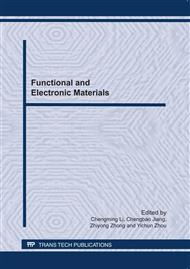p.122
p.129
p.133
p.138
p.144
p.151
p.158
p.163
p.167
Microwave Dielectric Properties of Ca(Li1/3Nb2/3)O3-δ Ceramics with ZnO Additive
Abstract:
The complex perovskite compound Ca(Li1/3Nb2/3)O3-δ(CLN) ceramics have received much attention due to the superior properties and relatively low sintering temperature 1150°C. In order to further low the sintering temperature of the CLN ceramics, enhance the Q · f values and other dielectric properties, the effects of the additive ZnO on the sinterability and dielectric properties of the CLN have been investigated. The CLN ceramics were prepared by conventional solid state ceramic route. With the addition of 1.0 wt% ZnO, the sintering temperature of Ca(Li1/3Nb2/3)O3-δ(CLN) ceramics was effectively reduced from 1150 ◦C to 1090 ◦C,and the Q · f value was increased from 18920 to 20950 GHz (at 7.09 GHz). It also possesses compatible dielectric constant εr of 27.8 and τf value of -23.57 ppm/◦C. While with the addition of 1.25 wt% ZnO, the Q · f value of Ca(Li1/3 Nb2/3)O3-δ (CLN) ceramics sintered at 1150 ◦C for 3 hours was increased significantly to 32150 GHz (at 7.09 GHz), εr of 28.3 and τf value of -18.55 ppm/◦C. The relationship between microstructure and microwave dielectric characteristics was studied using X-ray diffractometer and Scanning electron microscope.
Info:
Periodical:
Pages:
144-150
Citation:
Online since:
June 2011
Authors:
Price:
Сopyright:
© 2011 Trans Tech Publications Ltd. All Rights Reserved
Share:
Citation:


